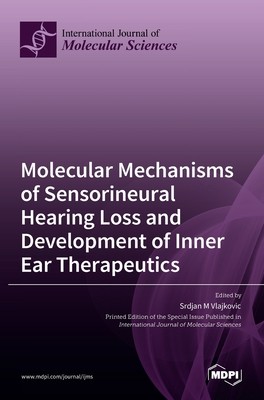
- We will send in 10–14 business days.
- Publisher: MDPI AG
- ISBN-10: 3036515062
- ISBN-13: 9783036515069
- Format: 17 x 24.4 x 1.6 cm, hardcover
- Language: English
- SAVE -10% with code: EXTRA
Molecular Mechanisms of Sensorineural Hearing Loss and Development of Inner Ear Therapeutics (e-book) (used book) | bookbook.eu
Reviews
Description
The sense of hearing is vulnerable to environmental challenges, such as exposure to
noise. More than 1.5 billion people experience some decline in hearing ability during their
lifetime, of whom at least 430 million will be affected by disabling hearing loss. If not
identified and addressed in a timely way, hearing loss can severely reduce the quality of
life at various stages. Some causes of hearing loss can be prevented, for example from
occupational or leisure noise. The World Health Organization estimates that more than 1
billion young people put themselves at risk of permanent hearing loss by listening to loud
music over long periods of time. Mitigating such risks through public health action is
essential to reduce the impact of hearing loss in the community. The etiology of
sensorineural hearing loss is complex and multifactorial, arising from congenital and
acquired causes. This book highlights the diverse range of approaches to sensorineural
hearing loss, from designing new animal models of age-related hearing loss, to the use of
microRNAs as biomarkers of cochlear injury and drug repurposing for the therapy of agerelated
and noise-induced hearing loss. Further investigation into the underlying
molecular mechanisms of sensorineural hearing loss and the integration of the novel
drug, cell, and gene therapy strategies into controlled clinical studies will permit
significant advances in a field where there are currently many unmet needs.
EXTRA 10 % discount with code: EXTRA
The promotion ends in 18d.04:49:35
The discount code is valid when purchasing from 10 €. Discounts do not stack.
- Publisher: MDPI AG
- ISBN-10: 3036515062
- ISBN-13: 9783036515069
- Format: 17 x 24.4 x 1.6 cm, hardcover
- Language: English English
The sense of hearing is vulnerable to environmental challenges, such as exposure to
noise. More than 1.5 billion people experience some decline in hearing ability during their
lifetime, of whom at least 430 million will be affected by disabling hearing loss. If not
identified and addressed in a timely way, hearing loss can severely reduce the quality of
life at various stages. Some causes of hearing loss can be prevented, for example from
occupational or leisure noise. The World Health Organization estimates that more than 1
billion young people put themselves at risk of permanent hearing loss by listening to loud
music over long periods of time. Mitigating such risks through public health action is
essential to reduce the impact of hearing loss in the community. The etiology of
sensorineural hearing loss is complex and multifactorial, arising from congenital and
acquired causes. This book highlights the diverse range of approaches to sensorineural
hearing loss, from designing new animal models of age-related hearing loss, to the use of
microRNAs as biomarkers of cochlear injury and drug repurposing for the therapy of agerelated
and noise-induced hearing loss. Further investigation into the underlying
molecular mechanisms of sensorineural hearing loss and the integration of the novel
drug, cell, and gene therapy strategies into controlled clinical studies will permit
significant advances in a field where there are currently many unmet needs.


Reviews